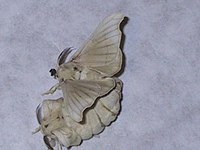
Photo from wikipedia
This study was conducted to determine optimum selection strategies for economically important traits in mulberry silkworm Bombyx mori. A total of 450 cocoons (225 males, 225 females) in each of… Click to show full abstract
This study was conducted to determine optimum selection strategies for economically important traits in mulberry silkworm Bombyx mori. A total of 450 cocoons (225 males, 225 females) in each of two strains, 107 (Japanese) and 110 (Chinese), were used to establish base populations. Studied traits were cocoon weight (CW), cocoon shell weight (CSW) and cocoon shell percentage (CSP), which were recorded individually. Six selection strategies including random selection (control), subjective selection based on cocoon appearance, selection based on CW, selection based on CSW, selection based on a selection index using phenotypic values and selection based on a selection index using estimated breeding values (EBVs) for CW, CSW and CSP, were used for three consecutive generations. Breeding values were estimated using an animal model based on derivative-free algorithm of restricted maximum likelihood. In each strategy, a total of 12 males and 12 females were selected and randomly mated to constitute 12 full-sib families in next generation. In each family a total of 50 individuals (25 males and 25 females) were randomly recorded for CW, CSW and CSP. Results showed higher CW and CSW in strain 110 and higher CSP in 107. Selection index based on EBVs resulted in higher values of CSW and CSP, compared to the control group. Selection strategies had different effects on different generations. However, EBVs for all traits significantly increased in total population. It seems that selection based on selection indices, especially using breeding values, is more efficient to improve all economically important traits.
Journal Title: International Journal of Tropical Insect Science
Year Published: 2019
Link to full text (if available)
Share on Social Media: Sign Up to like & get
recommendations!